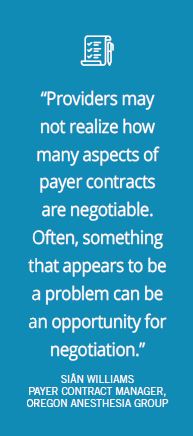As changes in the healthcare industry drive a shift from volume-based to value-based payer 
Successfully navigating this transition means overcoming challenges large and small, from scrutinizing minute details buried deep in payer contracts, to sidestepping potential conflicts that can derail provider-payer relationships.
But these challenges can be transformed into opportunities when providers harness innovation, collaboration, and creative problemsolving. In a competitive, changing market, skillful contracting can define revenue expectations, facilitate timely reimbursement, and prevent costly legal battles.
Just as importantly, creating effective contracts can help provider organizations define and understand their own market value. Through the contract process, providers can also harness and build negotiation skills.
“Providers may not realize how many aspects of payer contracts are negotiable,” says Siân Williams, payer contract manager for Oregon Anesthesia Group (OAG), an Oregon-based anesthesiologist group that contracts with every major insurance carrier. “Often, something that appears to be a problem can be an opportunity for negotiation.”
While the new healthcare landscape presents real challenges, providers can adapt and thrive by approaching contracts with an eye toward preventing conflict, optimizing partnerships, and building strong, resilient relationships. Williams shares her point of view on these issues.
CHALLENGE
An Increasingly Competitive, Cost-Conscious Healthcare Market
OPPORTUNITY
Partner with Payers to Maximize Market Value
Contracts that fail to define key terms or include vital subsections can spark conflict. The most effective contracts foresee and prevent potential conflicts, and provide a framework for conflict resolution.
SW: Conflicts can arise over a number of components in a payer contract, and it’s important to consider the smaller reimbursement components of the contract as well as the larger. For example, while anesthesia is our key reimbursement component, we may have carve-outs for subspecialty services that can impact revenue expectations. It’s important to specify how reimbursement will be managed for each subsection of the contract to prevent future problems. For example, there might be conflict over reimbursement on a subset of CPT codes.
While these codes may not be a major reimbursement component of the contract, they can create conflict when they’re not well-defined.
The management and timing of reimbursements can also be a source of conflict in contracts with payers. When a contract fails to define all of the reimbursement methodologies, billing procedures, and collection timelines, it can encourage disagreement.
When contracting with a payer offering a high-deductible plan, providers can run into challenges with collections, so it’s important to take those plans into account in the contracting process. One strategy is to consider the gap between the allowed amount and the collected amount, and use that data to evaluate contract value and push for higher reimbursement, because your patient accounts receivable will be higher.
Paying attention to billing timelines and the timing for appeals in contract language is key to revenue-cycle management and billing management. Knowing your state rules and regulations on billing timelines is helpful, and providers should negotiate timely filing guidelines to ensure that contract language doesn’t default to a national policy that may not work for the provider. It’s also important for providers to work with billing to ensure that they can meet the deadlines specified in the contracts.
Effective multi-year agreements spell out every aspect of a contract, from policy implementation to the claims-resolution and appeal process. When conflicts occur, and the provider has made every attempt to resolve the issue, there is also the threat of formal complaint. When providers have been reasonable, often the threat of formal complaint will motivate a payer to resolve the disagreement.
Going into discussions with a payer, it’s important for providers to know their own value proposition and be able to articulate how their participation adds value to the payer’s network. It’s also vital for providers to know their own market value; knowing the “reimbursement floor” can help providers hold their ground during difficult negotiations.
CHALLENGE
Policy Provision Roadblocks
OPPORTUNITY
Form Robust Relationships That Encourage Collaboration
Approaching potential problems with creativity and collaboration can help providers craft solutions to new challenges. Strong ongoing relationships between providers and payers allow physicians to continue working productively for the patients in their care.
SW: Bundled services can offer a nice solution to potential contract challenges. For example, the ACA has coverage provisions for preventative services like colonoscopy screenings. These services are now covered, but payers can have policies that limit aspects of that coverage. As a solution, providers can build a bundle with the facility that bypasses the policy. The payer gets one bill for everything, instead of separate bills for labs, radiology, anesthesia, and surgery.
Another opportunity is credentialing.
We approach credentialing by partnering our credentialing and contracting efforts. When credentialing goes awry, the process is not timely, it’s punitive for patients, and the provider’s AR grows. It’s important to keep patients’ interests in mind during these discussions with payers; timely credentialing is in the payer’s and provider’s mutual best interests. Developing and maintaining strong relationships with payers is key.
The success of contract management depends on good long-term relationships, which also help eith any conflict resolution. If we have a good relationship, everything goes more smoothly.